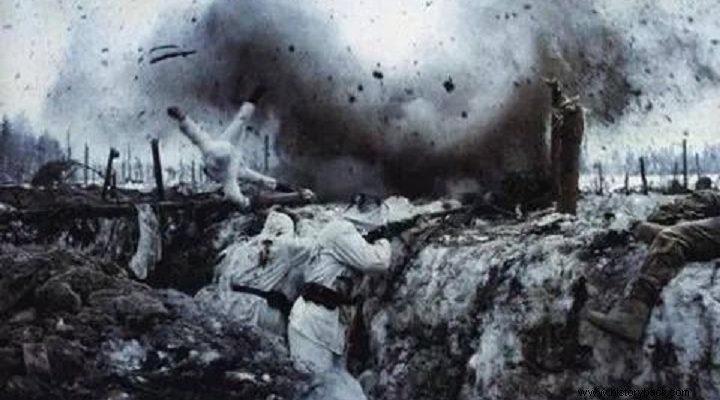
The Soviet attack against Finland was disastrous for the Red Army from the start. With the new year (1940) Stalin ordered the formation of a new Front (army group) headed by Tymoshenko. Zhukov was one of the bodyguards of the first. Tymoshenko was also endowed with new powers. So in January 1940 it had 23 Rifle Divisions, five tank brigades, 15 air regiments and 2,800 76-280mm guns – a density of 50 guns per kilometer of front.
Tymoshenko's plan called for an attack on the Isthmus of Karelia to break the Mannerheim Line. The area was full of lakes, rivers, marshes and forests with the exception of a 16 km wide gap at Viipuri. The Soviet attack would have its focus there.
The Finns had built in the area 35 small concrete forts (guns - patrols) equipped with machine guns and 37mm Bofors anti-tank guns. The site was organized as far as possible with battle and communication trenches, barbed wire, anti-tank ditches, anti-tank rock embankments and pillboxes. The Soviets had also attacked there in December 1939 but suffered overwhelming losses. At the end of January, however, the situation was different. Soviet artillery opened the gates of hell.
Soviet paver
This was followed, in early February, by test attacks on various parts of the Finnish defense.
Soviet fire was concentrated on two Finnish forts, the Popius fort and the "Millionaire" fort. These were the most modern Finnish fortresses. The "Millionaire" fort was seriously damaged by the Soviet bombardment. Its western active canopies were destroyed as was its main observatory.
On February 11, the main Soviet offensive was launched. The sector was held by the Finnish 3rd Infantry Division (IP) under General Harald Oquist. In the area of the fort, Major Lindmann's II/9th Infantry Battalion was deployed with only 400 soldiers maintaining a front of 2.5 km. Lieutenant Malm's 5th Company held the front at Fort Popius. Lieutenant Erickson's 4th Company defended the "Millionaire" fort, while Lieutenant Anous's 6th Company covered the front from the east in the area of the Munasuo marshes.
Opposite was the Soviet 123rd Rifle Division (MT) under Colonel Alyabuchev. Spearheading the attack against Popius was the 245th Rifle Regiment (F) reinforced with two companies of T-28 and T-26 tanks. Against the "Millionaire" rushed the 255th St. The Soviet artillery fiercely bombarded the Finnish positions. The fire was so powerful that it staggered the Finnish major. The Soviets pressed hard on the 4th Company and captured Finger Hill, in front of the Finnish first line of defense, despite Finnish counterattacks.
Russian tanks supported the infantry at close range. The Finns destroyed a few tanks but the Soviets did not stop and soon isolated the fort on the surface of which they were trapped. In the 6th Company sector the marshes prevented the Soviets from using tanks and their infantry were mowed down by the Finnish machine guns. At Popius fort the Finns reaped the first wave of the Soviet 245th St. They also neutralized four Soviet tanks. But there was much more. Dozens of them charged against the Popius fort and others approached the battlements, blocking the fire of the Finnish machine guns.
The Finns left the fort and continued to fight. A Soviet company was annihilated. Hundreds of Soviet corpses had filled the area 100m from the fort. But the numbers prevailed. At 13.28 the red flag flew at the fort. What was left of Malm's company after fighting for another hour retreated. Of the 100 men of the 5th Company, only 16 were standing. The Soviets, having captured Popius, moved to overflank the 6th Finnish Company in the marshes . The lone company was soon forced to retreat. Now only the "Millionaire" fort held.
The massive Soviet raid was again effective, despite casualties. The small fort was surrounded. Only eight Finns remained inside, but they continued to resist. Finally the active canopy of the small fort was blown up by the Soviets. At that moment there were only three defenders left. one of them survived, seriously injured. By February 12 the Finns had retreated. II/9th Battalion had lost 50% of its strength, but the Soviets had lost thousands. The Finns attempted a counterattack with four battalions to recapture the lost ground. Although they initially succeeded, they were stopped by the terrifying numerical superiority of their opponents.
